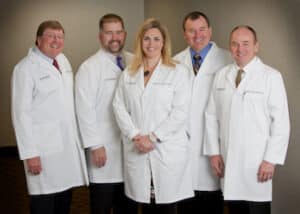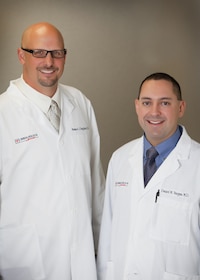Q. What is General Surgery?

A. General surgery is a surgical specialty that focuses on abdominal contents including esophagus, stomach, small bowel, colon, liver, pancreas, gallbladder and bile ducts, and often the thyroid gland. It also deals with diseases involving the skin, breast, soft tissue, and hernias.
The physicians at General Surgical Associates are all board-certified after completing five years of additional training following their medical doctor degree programs. This training involves learning how to evaluate a patient’s medical condition and determining whether surgery is the best type of treatment available. A General Surgeon receives extensive training in specific surgical procedures, presurgical patient consultation, and patient follow-up care. Our group routinely offers minimally invasive procedures, as well as robotic surgery.
Q. What is minimally invasive laparoscopic surgery?
A. Laparoscopy is a minimally invasive surgical procedure used to diagnose and treat problems of the abdominal and pelvic areas. During this procedure, an endoscope (tube) with a camera on the end is inserted through a tiny incision to allow your doctor to closely examine the organs of the area. Surgical instruments can be inserted through additional incisions to treat any identified problems.
Q. What is single site laparoscopic surgery?
A. Single site laparoscopy is one of the latest advances in minimally invasive surgery, reducing the amount of incisions to a single site. In traditional laparoscopic surgery, the surgeon makes three to six small incisions in multiple sites, inserts instrumentation through the incisions and performs the surgery. With single site laparoscopy only one incision is made through the navel. All of the instruments used in the surgery go through this single incision. All laparoscopic surgery offers significant advantages over open surgery, including shorter hospital stays, faster recovery time and reduced postoperative pain and complications.
Q. What are the advantages to single site laparoscopic surgery?
A. The main advantage is cosmetic; there is less scarring and in most cases the surgeon can make the single incision in a less painful area. For example, in traditional laparoscopic gallbladder surgery, four incisions are made in the abdomen in the navel, under the ribcage and along the right side of the abdomen. With the single site laparoscopic surgery, a single incision is made near the navel and the camera and instruments are passed through the single site. When the operation is complete, the patient has only a single incision and the scar will be hidden by the belly button. Should complications arise, the surgeon can make several additional incisions and complete the surgery as traditional laparoscopy.
Q. Is single site laparoscopic surgery always an option?
A. The goal of any surgery is safety. Only patients who meet certain criteria will qualify for single site laparoscopic surgery. Patients who have not had prior abdominal surgery and those who fall into a healthy weight range are ideal candidates. While gallbladder removal is the most commonly performed single site laparoscopic procedure, the effectiveness and advantages are still being studied for other types of surgeries. A surgeon experienced in traditional and single site laparoscopic techniques is a key factor in the efficacy and safety of the procedure.
Q. What is robotic surgery?
A. Robotic-assisted surgery is the least invasive and often most effective procedure available. Addressing the shortcomings of other types of surgery, robotic surgery offers many advantages to both patient and doctor. It combines the effective control of open surgery with the less invasive approach of laparoscopy.
Robotic-assisted surgery is usually performed with the da Vinci® Surgical System, a console made by Intuitive Surgical that is considered the best in these types of procedures. The system is comprised of a surgeon console, where the surgeon sits and operates the master controls as he views the operating area through real-time images; the patient-side cart, which has four robotic arms that actually perform the procedure as well as provide images for the surgeon; and the EndoWrist instruments, which are the tools that perform the intricacies of the procedure and are completely controlled by the surgeon.
Q. When is robotic surgery an option?
A. Robotic-assisted methods are also successful in treating heart, gynecologic and urologic conditions, which are typically treated with open and invasive procedures. Robotic procedures help eliminate large incisions and long recovery times, taking much of the worry out of undergoing complex surgeries.
Although robotic-assisted surgery is considered a safe alternative to more traditional methods, it is not for everybody. These procedures require good overall health, and all options should be discussed with a doctor before any decision is made.
Q. Do I need a General Surgeon?
A. Most patients are referred to see a General Surgeon from their own physician. If you aren’t sure if we can help you with your problem, call us, and our staff will be happy to answer your specific questions about the services we provide.


